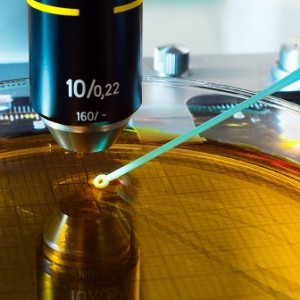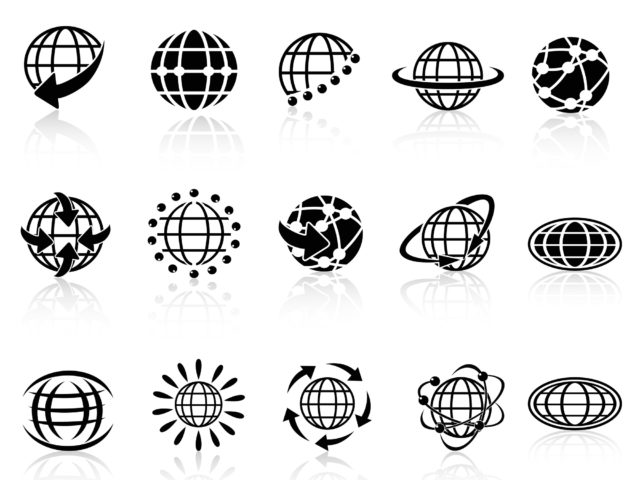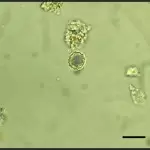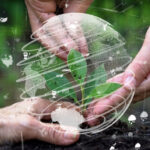
Environmental microbiology is a growing niche area related to environmental biology, but dealing with the biology of lifeforms too small to see with the naked eye. Environmental microbiologists examine microbes as they relate to the environment - their effects on the landscape and how they are affected by it. This will include the spread of viruses and bacteria, and the distribution of algae, fungi and parasitical organisms. Some of these have profound implications to human health and others provide vital services to the environment. Every form of life that shares the ecology with us performs a function for local ecologies.
Environmental microbiology is less concerned with the makeup and form of these lifeforms as it is with the distribution and relationship with the wider environment. Therefore, Geographic Information Systems is a necessary tool for the discipline. Those wishing to become GIS specialists within the field of microbiology in the U.S. have no specific options to study the method at undergraduate level. It is advisable to apply for an environmental microbiology program based on the availability of GIS as an elective or minor subject - where it is offered, it is important to take as an elective or minor it if you expect to work with geographic data. Those who wish to go into GIS specialism need to go on to further study to narrow their area of expertise.
With GIS, environmental microbiologists can work quickly and efficiently with the geographic data elements with which they sometimes work. In this, they are able to assist ecologist, health professionals and others in monitoring trends over a small or large area such as plotting the outbreak of disease (1, p50-9) or mapping distribution of microbial life (2). In this field, it allows specialists to examine local, regional, national or global trends to assist decision makers in plotting conservation strategies or where to allocation resources. Learn more GIS specialists.
How GIS Helps Environmental Microbiology
GIS applications lend an element of space-time to ecology, biology and microbiology and is therefore the ideal tool for monitoring environments, providing the most up to date information. It also permits researchers to examine historic information for trends and account for potential problems arising from natural and artificial forcings on an environment. It is already an important tool for ecologists the world over, and for biodiversity monitoring but its use is not yet widespread. As far as environmental microbiology is concerned, its application can be broadly broken into the following two areas:
- The first is micro biodiversity. It is one of the most important aspects of ecology to preserve and monitor the makeup of biological life within a given area. Yet we take for granted the importance of lifeforms that we cannot see with the naked eye. Viruses and bacteria, pollen, algae and spores are an important part of every ecosystem on the planet - often performing vital functions in the balance of nature. If we upset the delicate ecology of microbial life, then that could potentially have massive knock-on effects for other flora and fauna, and possibly even for us (3).
- The second is health and this includes human and ecological health. Specialists map the spread of disease in plants and in humans, and their potential to put a strain on medical resources, local economies or potential to become epidemic in the case of transmittable disease. We can also examine the environmental conditions that encourage microbes to spread or die off, and understand how the effects of climate change may affect them and by extension affect the ecology. Mapping the spread of disease when conditions are right for deadly fungi and parasites to give us insight into conserving algae and fighting viruses (4).
There are also ecological uses for environmental history. In understanding the ecology of the past, it is vital to examine the existing records of tiny forms of life such as fossilised pollen or bacteria. Monitoring natural changes or anthropological (historic human impact on the environment) (5, p22) over time can help us to not only reconstruct the environment of the past but also to plot models and make predictions of what might happen in future. Some of these microbes are very sensitive to even minor fluctuations in climate and as such they can help us understand the effects of changing conditions on our modern environment.
Case Study: Campylobacter and Farming
Campylobacter jejuni and Campylobacter coli are bacteria that cause food poisoning in humans; in fact, they are the most common causes of food poisoning in the UK (6) and is very common in the USA. Commonly found in areas where there is a large concentration of farming - particularly in areas heavy in poultry and dairy farming and where there are areas of untreated surface water - it leads to diarrhoea, gastroenteritis and other gut problems in humans. It is a microbe that can also cause debilitating illness in humans and though not deadly, there is an economic impact on areas when people are off work for extended periods of time. Where prevalent, it can put a large strain on health resources. It is known that the bacteria does not survive environmentally and cannot be transmitted directly from animal to person or vice versa and GIS was used in a recent study to ascertain some potential sources - standing water was already suspected.
In one major study, GIS was successfully applied in monitoring a known problem area in northern England (7). A range of data was applied in the study and the maps produced ascertained sources of the bug that was causing the illness in local human population. Samples were taken from areas of standing water and GIS used to plan the most relevant areas in relation to outbreaks, sampling water from areas of the most concentrated cases. Instances of the bacteria were high in the water samples - around 40% or so - and it was hypothesised that Campylobacter was being spread through faecal matter and urine, not draining away properly, and therefore working its way into the human food chain.
A similar study in Sweden revealed much the same results (8). Surveillance data in this case revealed a number of risk factors, collating disease instances against potential sources. There is still much that is unexplained about the bacteria, but in both cases we can plainly see the extent to which GIS has helped. Such information can be useful in that it helps health planners to understand how the agent spread and to identify possible causes of illness in areas where there is a large number of cases.
Case Study: Pathogenic Fungi
As the effects of climate change take hold, we expect to see further changes to the crops that we grow and on wild plants - the ecology will change and this may include instances of disease, bacteria and viruses. Food security is one of the major issues for the 21st century - the UN stated it as a goal for the near future to protect food supplies in a changing climate, in the developed and the developing world especially while we do not have the full picture of how this will affect human civilisation. Parasitical infection, bacteria, viruses and blight have two major impacts on the human environment.
- Widespread disease can challenge our food security and affect the volume of a crop - restricting supply and driving up prices. This is largely an economic problem that does not largely affect human health unless it leads to famine. Even in the west, we rely heavily on staple crops such as wheat and when affected by disease, these core crops can potentially have devastating effects. Diversity of crop types can affect how certain pathogens spread (9).
- Some biological diseases can adversely affect human health. The ergot bacteria for example can cause sickness and hallucination in people, and potentially lead to long-term health problems for individuals or populations. Though microbiologists do not research treatments, they are concerned with tracking the diseases and what may be done about them.
Climate change will present us with a whole new set of problems in relation to both of the above. We know that some areas are already suffering regular drought, others are suffering regular flooding and this will certainly have an impact on the virulence of certain diseases (10). GIS is already mapping these bacteria and viruses and expects to become a far more important tool in the future. One of the world's biggest projects is protecting our potatoes from blight. Annual crops depend heavily on controlling this pathogen that has the potential to cause famine in the developing world. GIS has been used extensively and successfully in plotting problem areas and compiling strategies to limit the disease and prevent it spreading (11). Integrating climate data with paths of known pathogens, researchers can predict the potential spread based on variations and instability of the climate.
Case Study: Palaeodata
Environmental science is not just about what our ecology looks like today, there are many researchers interested in what the environment of the past looked like - throughout human history and the ancient environment. We call this “the palaeoenvironment”. Collecting palaeodata can help us understand many aspects of the world in the distant; by extension it can shed light on the Great Extinctions of the past. Palaeoenvironmental researchers study biological data, including microbes, as far back as the dawn of life of life on this planet where such data is available.
Famously, the Greenland Ice Sheet data sets have allowed us to reconstruct a temperature record going back more than 600,000 years (12) based on our understanding of the carbon level and atmospheric makeup. Researchers have also collected large amounts of microbiological data from the past. In such studies, GIS is used to plot relevant sites to get either the broadest range of environments from which to collect data, or to sample from concentrations when looking to answer specific questions.
In another study, GIS was used to map the topography of palaeovegetation in south-western Turkey (13). An unpublished dissertation, it commented extensively on the lack of use of palaeoenvironmental modelling in general throughout the academic world in this area, yet it used GIS to attempt to answer the following three questions:
- Whether and to what extent climate change might account for evidence of lakes and nature of vegetation of the area in question.
- To map and account for a lack of tree expansion in the Holocene in the area - to define an effective vegetation modelling of the unique nature of Turkey's climate.
- To map the extent of human occupation of the culture known as Beyşehir and account for the changes to the ecology.
The study examined mostly pollen evidence - one of the most ubiquitous ecological records that can survive in a variety of conditions and one that microbiologists study in great details. The results were not just useful for palaeoecology, but for archaeology and modern historians too.
Related Degrees
Sources
- Longley, P.A., Goodchild, M.F., Maguire, D.J. & Rhind D.W. 2011: Geographic Information Systems & Science (Third Edition). Wiley: Hoboken, New Jersey
- http://www.sciencedirect.com/science/article/pii/S1468164110600874
- http://www.sciencedirect.com/science/article/pii/S0261219413001749
- http://annali.unife.it/museologia/article/viewFile/408/356
- https://www.food.gov.uk/science/microbiology/campylobacterevidenceprogramme
- http://aem.asm.org/content/71/4/1876.full
- http://www.ncbi.nlm.nih.gov/pubmed/15061507
- http://www.sciencedirect.com/science/article/pii/S0261219413001749
- http://www.researchgate.net/profile/Gregory_Forbes/publication/227626696_Estimating_the_global_severity_of_potato_late_blight_with_GISlinked_disease_forecast_models/links/00b4952a89e7db4a66000000.pdf
- http://www.researchgate.net/profile/Jacob_C_Yde/publication/253533846_Basal_ice_microbiology_at_the_margin_of_the_Greenland_ice_sheet/links/02e7e523822bb9f0b8000000.pdf
- http://etheses.bham.ac.uk/4179/1/McMillan13PhD.pdf
- Guide to Parasitology - November 19, 2018
- Deserts as Ecosystems and Why They Need Protecting - November 19, 2018
- Conservation: History and Future - September 14, 2018
Related Articles
Featured Article

Geoscience: Unlocking the Planet’s Nature





